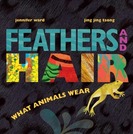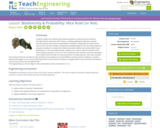
Introduction to the characteristics found in different animals and using the book: Feathers and hair, what animals wearAuthor:Jennifer Ward; Jing Jing Tsong

Introduction to the characteristics found in different animals and using the book: Feathers and hair, what animals wearAuthor:Jennifer Ward; Jing Jing Tsong

This video segment from NatureScene features the area of the Congaree Swamp where the high ground and the flood plain meet. Learn how a few feet of difference in elevation on a floodplain can yield drastic changes in what youŰ__Ű__Çll find living there.

This video segment adapted from NOVA scienceNOW shows how the common wood frog freezes solid every winter, an adaptation that allows the organism to survive the cold winter.

This video segment from Outdoor Nevada looks at the Gila monster's behavior, habitat, and unique adaptive characteristics.

Teachers can download this teaching package that discusses insects and insect adaptations. Students will enjoy the hands-on activities described in the lessons. Teachers will appreciate the student handouts provided, as well as the list of resources.

In this video from Outdoor Nevada, learn about the habitat, diet, and defense mechanisms of horned lizards.

This inquiry lab activity involves students working to observe and describe to how worms will interact/adapt with their environment.

In this video segment adapted from the National Film Board of Canada, learn how the Inuit people have used their traditional knowledge to understand and adapt to changes in their Arctic environment, particularly when hunting and navigating the landscape.

Join Ike when he travels in the Arctic to learn about how animals adapt to cold environments.

Students use an inquiry approach to describe the major biomes of Minnesota before taking a look at adaptations that make organisms successful in their environments.

This is a lesson designed by a biology teacher. In it, students use maps and evidence of island age, molecular genetics, morphology, and distance apart to determine how the islands came to be occupied by different species of lizards. It will take some time and requires extensive background knowledge.

In this scene from the 2007 Masterpiece film of Jane Eyre, Jane is walking alone on the moors. The mood is tranquil, yet there is a hint of foreboding. Suddenly, Jane's quiet contemplation of nature is crosscut with the image and sound of a horse galloping thunderously. The music changes, and we know something dangerous is about to happen. Out of the mist comes a riding figure. Before Jane can move out of the way, the horse rears up. We see the horse on the ground, and the man yells at a dog, "Quiet, Pilot. Dammit!" Jane asks, "Are you injured, sir?" The man replies harshly, "Get away from me. Witch. (You've) done enough damage." Jane identifies herself, but Mr. Rochester does not. Leaning on Jane for support, he gets back on his horse, groaning. "That's what happens when you bewitch a man's horse, Miss Eyre," he says, "a lot of pain and cursing." Jane, although shaken by the incident, corrects him: "I did not bewitch your horse, sir." When he orders her home, she says, with a tiny bit of defiance in her voice, that first she will finish her errand. [2:34] Teaching materials are included.

Explore the meaning of kindness, love, and forgiveness in this video excerpt from Les Miserables, Masterpiece. Based on the famous novel by Victor Hugo, the production tells the story of Jean Valjean, who emerges from 19 years in a forced-labor prison-where he was sent for stealing a loaf of bread for his hungry family. Angry and vengeful after his cruel treatment, he is suspicious and astonished when he encounters Monsieur Myriel, the Bishop of Digne, who offers him food, shelter, and the opportunity for redemption. [3:08] Teaching materials are provided.

This article highlights lessons that help K-grade 5 students understand that animals and plants can only survive in certain environments.The lessons support the theme of an issue of the free online magazine Beyond Weather and the Water Cycle. The theme is "We Depend on Earth's Climate."

This Nature video shows the migratory patterns and habits of the Rufous hummingbird.

This site from the National Zoological Park provides extensive information about many types of animals. Just click on the category you need. Includes pictures and live web cams.

Students explore the relationships between genetics, biodiversity, and evolution through a simple activity involving hypothetical wild mouse populations. First, students toss coins to determine what traits a set of mouse parents possesses, such as fur color, body size, heat tolerance, and running speed. Next they use coin tossing to determine the traits a mouse pup born to these parents possesses. These physical features are then compared to features that would be most adaptive in several different environmental conditions. Finally, students consider what would happen to the mouse offspring if those environmental conditions were to change: which mice would be most likely to survive and produce the next generation?

Viktor brought his pet plant on his trip to Nova Zembla. Help him figure out what to do to take care of the plant.

In this biology activity, students will first brainstorm how humans use their hands. They will then conduct a short experiment to determine the importance of the opposable thumb to humans and how it is an important adaptation.

From the Evidence for Evolution Library at PBS, this is a short article about biogeography. The distribution of animals is one source of evidence for Darwin's descent with modification.